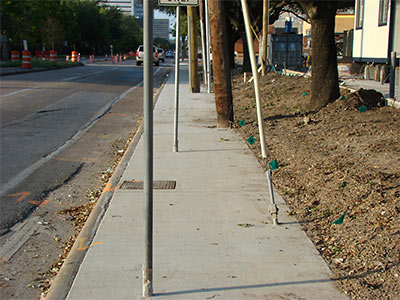
The wise folks behind Greenway Commons — the new shopping center replacing the old HISD headquarters building at the corner of Richmond and Weslayan — have apparently taken some extra-special steps to make sure the new development (which includes a brand-new Costco) is super-friendly to pedestrian visitors!
Making everything welcoming to people arriving on foot makes sense — the project had been criticized for exhibiting suburban-style development patterns in a location that some dreamers had imagined would be a street-fronting mixed-use center. It’s already a busy corner, and Metro’s new University Line will have a stop only a short walk away.
But “easy to access” can also mean “boring.” So it’s comforting to see these pictures of the project’s street edge sent in by a reader, which show a gentle, fun infrastructure-themed obstacle course taking shape along the new Weslayan and Richmond sidewalks in front of Trammell Crow’s grand development:
***
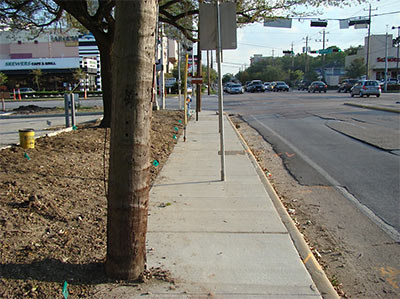
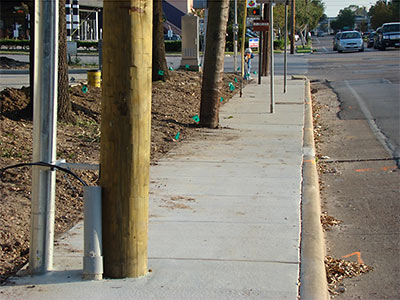
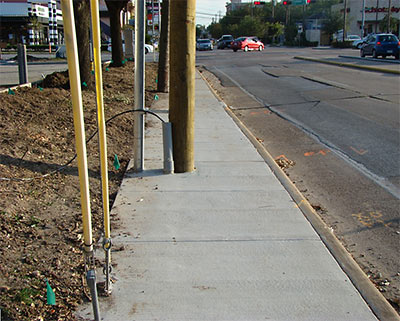
It looks like visitors and passers-by in wheelchairs will be able to get in on the entertainment too, as they navigate this ramp at the corner of Weslayan and Richmond:
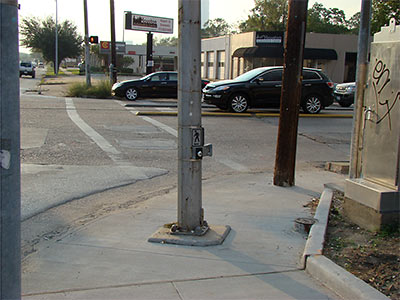
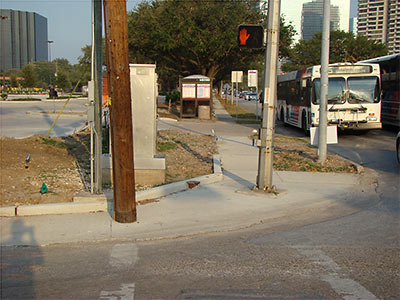
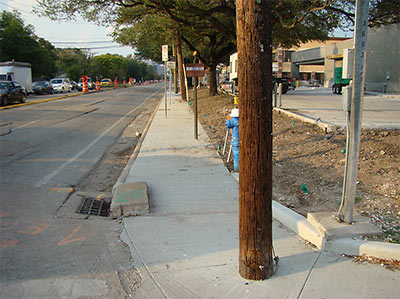
Bicyclists won’t be left out either — they’ve got a fun lane too!
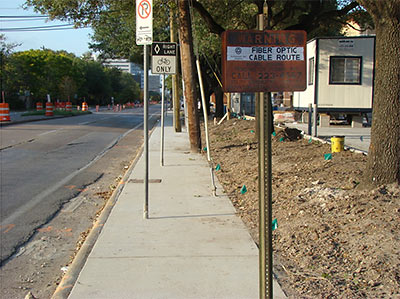
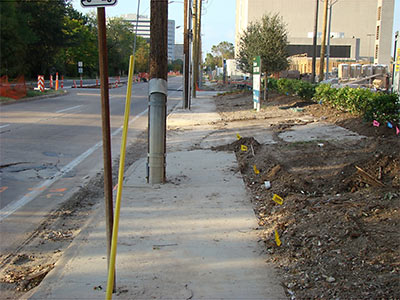
Sadly, the reader who sent these photos has no appreciation for the years of careful planning that went into creating this unique project:
what genious approved the sidewalks along Weslayan and Richmond? How would the ADA approve this? Does common sense and an Engineering Degree in Texas allow obstacles cemented in sidewalks? Is this what the Department of Public Works and Engineering approves?





Aw, quit bitching. Just back your Diesel Expedition up to the loading area, leave the engine running and load up the 500lb. pallet of Eukanuba Custom Care Stomach Sensitive dog cuisine. :-)
“what genious approved the sidewalks along Weslayan and Richmond? How would the ADA approve this? Does common sense and an Engineering Degree in Texas allow obstacles cemented in sidewalks? Is this what the Department of Public Works and Engineering approves?”
The city, utility companies, and ADA handicapped the developer and engineers from building an appropriate sidewalk. These sidewalks along the road are also just replacement sidewalks. The developer is required to restore them to the existing condition and not improve them (unless the city ponies up some money). The city or a TIRZ district would have to improve them as part of a pedestrian enhancement project or street reconstruction project.
The Richmond side walks will be completely replaced anyway since Richmond will be rebuilt as apart of the light rail construction (hopefully). The light rail actually turns onto Cummins to head towards US 59, so this block of Richmond may be left alone.
The reality is that the Public Works department will never get adequate funding to do things right everywhere because they aren’t politically sexy. Yes, what they do is vital, but funding is only increased when bad things happen (flooding, sewer backup, water service stops, pothole engulfs a car). The mayor and city council members will fund things like sports stadiums, convention centers, flashy parks, and social programs because they buy votes. Public works projects never get politicians elected and can often lead to them getting kicked out of office.
The ADA only comes into effect for complete rebuilds also, but making old sidewalks fit the complex ADA standards often make for some interesting projects. drive along Elgin from Bagby to Travis and you’ll see a new pedestrian enhancement project. The funding came from the Midtown TIRZ though, but the city had to approve the design.
The old HISD building was beautiful. Its destruction was a sin…for a Costco. Way to go Houston.
I agree that the old HISD building was beautiful in terms a Brutalist Architecture, but it was a complete waste of taxpayer money.
The building had tons of wasted space and quickly ran out of useful office space. HISD’s new headquarters has much more room, it’s more efficient in design, and it allowed the non-taxable acreage of their old headquarters to become a productive tax generating piece of land.
In an age of rampant government waste, the this was actually a smart move by HISD.
Yes, selling the Taj Majal was by far the right move by HISD. While it may have been an interesting piece of architecture to some, that was drastically overshadowed by the fact that a school district’s headquarters should be functional and cost efficient, and not an example of opulence at taxpayer expense. The new HISD headquarters is in a convenient location on the North Loop at 290 and it’s also a reasonably valued piece of property, connected to other district sports complexes. While snobs and elitists may look down their noses at warehouse stores like Costco, the inner loop area has long lacked a venue like Costco which targets higher end buyers than stores like Sams. Not everyone always wants to have to shop at boutique stratospherically priced stores that choose not to deal in cost efficient volumes so that people can walk there. I personally love shopping at Costco. My extremely successful single grandmother realtor buddy loves shopping at Costco all the time. Now she’s thrilled the new one’s open a mere several blocks from her townhouse. Just because you make good money doesn’t mean you shouldn’t shop prudently.
This is just lazy. At least move the signs to the grass.
kjb434, you need to do some research. ADA compliance is not thrown out the window when you have a rebuild of an existing facility. There is adequate space to have built the sidewalk behind a planter strip which would have been more appropriate anyway. Besides, those bike lane signs are pointless when the bike lane essentially doesn’t exist, thereby becoming pointless obstacles. The city is requiring the developer to reconfigure the intersection for cars but they didn’t ensure compliance with a federal law? Ingenious. On top of that, if anyone, ped or wheelchair-bound gets killed having to step/roll into traffic to navigate that pathetic obstacle course at the corner then it will potentially cost Houston/Trammel Crow a whole lot more in the long run.
Cesspool,
Working at an Engineering firm that worked on many pedestrian enhancement project in Midtown and Downtown along with countless new development, I’m fairly versed in the ADA rules.
In a simple reconstruction/repair as this was, the ADA rules don’t apply. If the sidewalk were being completely rebuilt (new signs for the road, reworking the electrical poles) ADA would haven’t definitely played a roll. Also, ADA sets guidelines that must be administered by the State of Texas and the City has answer to this if complaints are brought. The city is protected is this case.
Also, the intersection you mention was just a simple left turn lane added to an existing median break. The city didn’t require them to do anything. The developer wanted the left turn lane and had to apply for it. The city could have turned them down. Since the developer pays for this left turn lane, the city ensures it meets its standards for the roadway add-on.
ADA does come into effect for existing facilities when a threshold is met for reconstruction/remodeling. Many buildings avoid remodeling because it forces them to build for ADA compliance which forces them to put in elevators and ramps. Yet some smaller remodeling projects don’t require it because the threshold isn’t met. There are several two story restaurants that don’t meet ADA rules and were remodeled recently. They were under the threshold.
People need to stop blaming the developer for following rules and complain to their council member that the city doesn’t provide and adequate sidewalk along Wesleyan and Richmond for wheel chair use. The developers aren’t the problem, but inept city government is.
AASHTO Guide for the Planning, Design, and Operation of Pedestrian Facilities
The purpose of this guide is to provide guidance on the planning, design, and operation of pedestrian facilities along streets and highways. Specifically, the guide focuses on identifying effective measures for accommodating pedestrians on public rights-of-way. Appropriate methods for accommodating pedestrians, which vary among roadway and facility types, are described in this guide. The primary audiences for this manual are planners, roadway designers, and transportation engineers, whether at the state or local level, the majority of whom make decisions on a daily basis that affect pedestrians. This guide also recognizes the profound effect that land use planning and site design have on pedestrian mobility and addresses these topics as well. 2004. Paperback. 142 pp.
Item Code: GPF-1
Download Item Code: GPF-1-UL
Price per Copy: $90 * AASHTO Members: $75
Also available in ssingle-user CD-ROM.
Item Code: 12-GPF-1-CD (single-user CD-ROM)
Price per Copy: $138 * AASHTO Members: $115
I know the book very well. I have it on my desk and the previous version was used in my Transportation Design courses in college.
A little tip on AASHTO design guidelines: if Federal and/or State funding is not utilized for a project, the guidelines can be tossed in the trash. They are a fall back when local governance has no previous standard in place.
Harris County makes the decision on low speed roads (45 mph or less) to not use super elevation for tight curves as AASHTO requires. In our geographical environment, roads are also utilized for conveyance of surface drainage. Not using super elevation for major thoroughfares under 45mph (which is pretty much all of them) forces water to pond on the outside lanes. This leaves the inside lane with little or no ponding to continue to allow traffic and especially emergency vehicles a consistent lane to drive in. Houston doesn’t necessarily follow this, but there are other areas that they don’t follow AASHTO. Intermediate cross walks for pedestrians is one. AASHTO suggest flashing yellow lights and painted crosswalks for pedestrian crossing that are needed mid-block. The FHA advises against this. The city of Houston decided to use the FHA guideline. An FHA study found it was safer for a pedestrian to cross mid-block without cross walks because the cross walks gave the pedestrians a false sense of security. The only time the cross walk should be painted is if it was protected by a red light signal which generally is at intersections. The Galleria has two at mid-block, but they are protected by a red light signal.
Actually the courts decide when ADA applies. You can get sued at any time for lack of ADA compliance whether new or old construction. You need to check the ADA regulations not AASHTO (Though this is a good document) to determine what is appropriate. It would have taken very little to make this sidewalk ADA compliant. You would need 30 inches wide at obstacles and overall five feet wide sidewalks and detectable warnings and you would have it. It is too bad that the locals have given a “buy” on fixups as not requiring ADA compliance, especially when the appropriate measures could have been easily accomplished.
This is NOT a fix-up…it is different kind of “f”-up! The original sidewalks along Weslayan were removed and the sidewalks in the pictures (with all the cemented-in obstacles)are NEW poured sidewalks. In fact – in one location along Weslayan, Trammell Crow and their highly intelligent contractors did not even cut for a wheel chair ramp! Anyone proclaiming to have an engineering degree and proud of working for the City or the Developer and their subcontractors should lose their degree and any other credentials. What a joke!
kjb434, I too am familiar with ADA as a transportation planner (though not in Texas). And given Houston’s transportation and land-use record I don’t care to be.
But, it is pretty pathetic that, as an engineer you would state that a reconstructed sidewalk doesn’t need to be ADA compliant. A repaving of the road triggers ADA upgrades for crying out loud. And you contend that a completely reconstructed sidewalk doesn’t have to be upgraded?
And again, address my points; there are a variety of basic flaws such as sign placement and width that could have easily been changed to comply in many cases. I don’t know who was responsible for the reconstruction (I assume the developer as a condition of the redevelopment of the site). Regardless, the sidewalk needs to be made compliant.
It goes to whose responsible for the work.
The road was not being repaved or reconstructed. Just a turn lane in one spot.
The sidewalk was is massive disrepair, but it is not the developers job to rebuild it beyond the previous state. That is the city’s job.
The city could have pressed the developer to do it as a condition of plan approvals, permit approvals, etc.
Does this mean that any homeowner doing some remodeling or even a rebuild on a lot must bring the sidewalks in front into ADA compliance too? Does this also mean that any commercial building that is constructed and/or remodeled must also make the sidewalks in public right of way ADA compliant?
The issue comes down to who gets defined as at-fault if an ADA complaint is made to the state agency that enforces the federal guidelines. The developer and Costco are only responsible for what happens where they connect driveways to the street to be ADA compliant in the public right of way. ADA compliance for the developer is a concern within their property.
I understand the pictures show a sorry excuse for a sidewalk, but the developer isn’t responsible for upgrading and improving the sidewalk. The developer fixed a sidewalk in dis-repair on their own accord. My objection is the blaming of the developer. The real party to blame would be the City of Houston and the Planning Commission.
Also, if citizens truly felt this sidewalk was so horrible and so bad, why would they complain about it on the internet? Why not make the phone calls for the ADA complaint?
I don’t live near the Costco or involved in projects near it, so it’s not affecting me. I have plenty of other neighborhood issues in my own area of Houston that I help my community with.
The residents and workers in the area that would utilize this sidewalk should take some action. Usually ADA complaints made to political officials don’t go un-resolved. Call a TV news crew and make a stink about it. Get a wheel chair bound person to try to navigate it on camera.
looks like a fun slalom corse for a skateboard/rollerblader
ADA is triggered by any alteration of the roadway or the sidewalk. However, the sidewalk at first glance from the photos appears to show the required 3-ft wide accessible route. Also, a widened area for turning around or passing wheelchairs is req’d every 200 ft – these can be provided by intersectino treatments.
That being said it is certainly not a very smart design if people arre actually going to want to walk here. Unfortunately you can’t legislate a desire to make streets ped friendly if the municipality just doesn’t have the will.